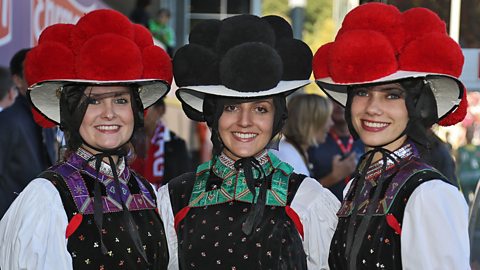Translating the perfect tense
The format of the perfect tense looks like a direct translation from English, especially if we look at an example with near-cognateA word that is similar to one in another language and whose meaning is easily recognisable, eg mehr (German) and more (English)., eg:
- ich – I
- habe – have
- gemacht – made
But we should remember to translate ich habe gemacht as 'I made' rather than 'I have made'.
Here's an example using sein:
- sie – she
- ist – is
- gegangen – gone
We should remember to translate sie ist gegangen as 'she went' rather than 'she has gone'.
Look at these other examples, and note the correct translation:
- ich habe Tennis gespielt – I played tennis (literally: I have tennis played)
- mein Bruder hat mir geholfen – my brother helped me (literally: my brother has me helped)
- wir sind zusammen gefahren – we travelled together (literally: we are together travelled)
Question
Change these five present tense sentences into the perfect tense using haben.
- Sie kauft eine Tracht. – She buys/is buying a traditional dress.
- Ich esse ł§±čäłŮłú±ô±đ. – I eat/am eating ł§±čäłŮłú±ô±đ.
- Ich spiele Handball. – I play/am playing handball.
- Wir tragen eine Uniform. – We wear/are wearing a uniform.
- Sie sehen den Film. – You (formal) watch/are watching the film.
- Sie hat eine Tracht gekauft. – She bought a traditional dress.
- Ich habe ł§±čäłŮłú±ô±đ gegessen. – I ate ł§±čäłŮłú±ô±đ.
- Ich habe Handball gespielt. – I played Handball.
- Wir haben eine Uniform getragen. – We wore a uniform.
- Sie haben den Film gesehen. – You saw the film.
Question
Change these five present tense sentences into the perfect tense using sein.
- Wir fahren nach Deutschland. – We travel/are travelling to Germany.
- Ich gehe zum Supermarkt. – I go/am going to the supermarket.
- Ich schwimme im Meer. – I swim/am swimming in the sea.
- Er läuft jeden Tag. – He runs every day.
- Sie fliegt nach Amerika. – She flies/is flying to America.
- Wir sind nach Deutschland gefahren. – We travelled to Germany.
- Ich bin zum Supermarkt gegangen. – I went to the supermarket.
- Ich bin im Meer geschwommen. – I swam in the sea.
- Er ist jeden Tag gelaufen. – He ran every day.
- Sie ist nach Amerika geflogen. – She flew to America.
Question
Change these five present tense sentences into the perfect tense. Do you need to use haben or sein?
- Er isst den Kuchen. – He eats/is eating the cake.
- Die Katze läuft hinter das Sofa. – The cat runs behind the sofa.
- Spielst du Fußball? – Are you playing football?
- Ich höre die Nachrichten. – I hear/listen to the news.
- Wir bleiben hier. – We're staying here.
- Er hat den Kuchen gegessen. – He ate the cake.
- Die Katze ist hinter das Sofa gelaufen. – The cat ran behind the sofa.
- Hast du Fußball gespielt? – Did you play football?
- Ich habe die Nachrichten gehört. – I heard/listened to the news.
- Wir sind hier geblieben. – We stayed here. (remember that bleiben is an exception that takes sein)
Did you know?
Many women own eine Tracht or ein Dirndl, which are two different names for a traditional dress worn at folk festivals, especially in the south of Germany, Austria and Switzerland.
In Germany's Black Forest region, some women complete their traditional outfit with a Bollenhut – a wide-brimmed, straw hat decorated with red or black pompoms. Traditionally, unmarried women wear hats with red pompoms and married women wear hats with black pompoms.
The Bollenhut is said to have been the inspiration behind the Black Forest gateau – ł§ł¦łó·É˛ą°ůłú·Éä±ô»ĺ±đ°ů°ěľ±°ů˛őł¦łółŮ´Ç°ůłŮ±đ. The large pale brim represent the cream – die Sahne, and the red pompoms represent the cherries – die Kirschen on the top.
